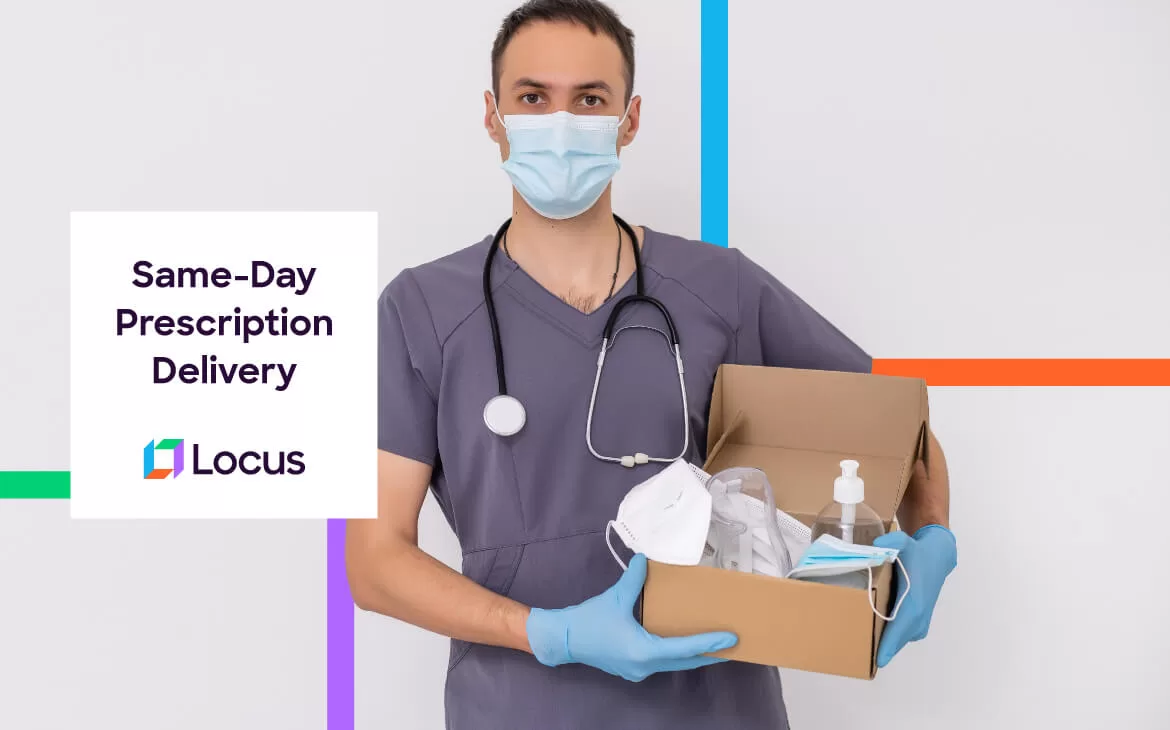Delivery Experience, Healthcare / Pharmaceutical
Top Challenges in Enabling Same-Day Prescription Delivery
Oct 19, 2021
12 mins read

Can I order my medication online?
This was a question that users would google more than a decade ago. That was the time when e-commerce had just started to make its presence felt globally. But as the years passed by, things have taken a drastic turn. In a post pandemic world, the google searches have since evolved to:
- Can I get my prescriptions the same day?
- Which pharmacy delivers prescriptions the fastest?
- Which app delivers medicine the fastest?
- Which is the best prescription delivery service?
- What are some same-day prescription delivery apps that will save me money?
- Which pharmacies have free deliveries?
These questions reflect how users are rampantly looking out for the same-day delivery of their prescriptions. This demand has skyrocketed during the pandemic, and many businesses have been struggling to cope. One thing is clear from the above google searches: consumers want the fastest, economical, reliable, and efficient same-day prescription deliveries.
What is same-day prescription delivery?
Same-day prescription delivery is the delivery of prescription products within 24 hours of when a consumer orders medicines. It enables consumers to obtain prescriptions within the same day without having to wait in long queues of pharmacies. Also, this is the most preferred delivery method for selling time-sensitive products in the pharmaceutical industry.
Why has it become essential to deliver medicines on the same day or on-demand?
Balancing convenience with safety
The biggest reason for the popularity of same-day prescription delivery is its convenience. With the coronavirus outbreak, people feared to shop for their prescriptions in person. This led them to reach out to numerous pharmacy businesses offering same-day delivery.
With the recent developments in e-commerce and logistics technologies, people, from the comfort of their homes, can get their prescriptions delivered the same day and reduce the risk of contagion. Same-day prescription delivery has become a necessary lifeline for patients living in areas without any pharmacy stores nearby. It has become a priority for the pharmaceutical industry as it meets the customers’ need for convenience and safety.
Saves time and money
It is difficult for patients to track the purchase and consumption of prescriptions in larger quantities for a definitive period. Same-day prescription deliveries help them track and manage the purchase and consumption of their medications in larger quantities. It provides options for them to reorder their prescription deliveries after a number of days, which helps patients with chronic illnesses save time that goes in making repeated orders.
Same-day prescription deliveries also help customers to monitor their spending on medicines through a subscription model.
Ex: The savings from a 30-day subscription to buy medicines are often lower than a 90-day subscription. This may not be a case of concern for patients with short-term illness. But for patients with chronic conditions that require year-around medication, it could make for a windfall. Same-day prescription delivery also helps them quickly reschedule and automate their second round of medications. Even if they have a tendency to forget to order their prescriptions, they can set reminders periodically to get them delivered. This enables them to save time and expenses in ordering their medications.
Reach out to people with reduced mobility
When the COVID-19 pandemic hit the global population, the most affected were people with reduced mobility. Lockdowns and social distancing meant getting essential drugs for treatment became more burdensome for them during the pandemic. Prescription delivery services have helped them obtain their medicines with a few clicks.
More than convenience, same-day prescription delivery has become a life-saving option for people with mobility impairments like the injured, the disabled or the elderly. It helps them avoid the great difficulty of getting into a pharmacy to pick up a medication.
Opportunity to gain repeat business
The sudden spike in on-demand pharmacy deliveries created new avenues for pharmacists to boost their sales. With same-day prescription delivery, they can impress their customers with speed and professionalism. As their same-day delivery performance improves consistently, buyers will spread a positive word of mouth, eventually leading to repeat sales.
Same-day prescription delivery enables many local pharmacists to tie up with remote online distributors and gain new customers.
Added privacy protection
For customers, there is the fear of the misuse of their personal information when they purchase prescriptions from a brick-and-mortar store. A patient’s medical information is quite sensitive and its access should be prohibited from strangers.
Same-day prescription delivery limits the exposure of data and helps buyers keep their information secure and private. This delivery service’s added privacy protection makes it a safer and reliable way to buy crucial medicines and drugs.
Challenges in enabling same-day prescription delivery during COVID-19 and lessons learned

The COVID-19 pandemic has opened up new healthcare options that can make society resilient during these uncertain times and in the future. Today, one of the most significant needs for Americans is getting medications on time, and the best delivery option is a same-day prescription delivery. Since this pandemic, it has become a public health necessity rather than a matter of convenience.
As time passes, same-day prescription delivery will become the new normal just like food and grocery deliveries are today. Though an investment into same-day medicine delivery is a profitable option, it has numerous challenges.
Challenge No 1: Difficulty to balance fleet with the volatile demand
The pharmacy businesses involved in same-day prescription delivery are facing difficulties with meeting demand fluctuations. With the coronavirus outbreak, there has been a steep rise in the demand for prescription products. And pharmaceutical businesses found it challenging to rightsize their fleets’ requirements for these rapid demand changes.
Lesson learned: Improve fleet scalability
Fleet scalability is the ability of a fleet to retain its delivery performance amid growing delivery requests or loads. The daily number of deliveries a pharmacy handles may vary based on numerous factors, and it is difficult to forecast demand.
As medicines are a life-saving product with strict time priorities, pharmaceutical companies must improve their handling of ad-hoc deliveries. Because a business’ fleet scalability is really tested when it faces a higher number of ad-hoc deliveries.
The biggest lesson for pharma businesses involved in same-day prescription delivery is to handle ad-hoc pharma deliveries effectively.
Challenge No 2: Weaknesses in logistics coordination
As pharma businesses are implementing same-day prescription delivery, the biggest obstacle they encounter is weaknesses in logistics coordination. Whether shipments fail, are incorrectly delivered, or delayed, the reason is a fleet’s inability to streamline logistics operations.
Lesson learned: Improve tracking abilities
If you face increasing delivery delays, failed deliveries, missed deliveries in same-day prescription delivery, you are not alone. The solution lies in how pharma businesses upgrade their tracking abilities and communication processes.
Enabling real-time communication between the drivers and the pharmacy ensures that deliveries are appropriately tracked and coordinated. This includes keeping track of completed deliveries, managing inventory levels, and maintaining patient records.
Challenge No 3: Difficulty to manage varying delivery preferences
The success of pharmacies in same-day prescription delivery depends on prioritizing home deliveries and fulfilling patient expectations.
As demand for same-day prescriptions grows, pharma businesses face difficulties in managing the various delivery preferences of consumers. This may lead to burdening the available assets and resources, resulting in falling productivity levels.
Lesson learned: Enabling effective allocation of delivery requests
As orders keep piling up, pharmacies or fleet managers should focus on effectively allocating delivery requests to their resources. When any logistics operation is staring at a shortage of drivers, it becomes essential to optimize deliveries without burdening their drivers.
Allocating the maximum delivery requests with tighter delivery windows leads to drivers spending maximum time on the road. This may cause vehicle downtimes, idling, and higher accidents, thereby impacting the drivers’ mental health. Low driver satisfaction translates to higher attrition rates and higher onboarding costs.
While building delivery schedules, fleet managers should improve Service Line Agreements (SLA) and minimize the workload of fleet drivers simultaneously. This helps drivers reduce the time spent on the road, thereby improving vehicle health and driver’s mental well-being.
Evolution of Healthcare Supply Chain. Download WhitePaper Now!
Challenge No 4: Difficulty keeping up with on-time delivery rates
Patients with regular, long-term, and urgent medication needs turn towards same-day prescription deliveries for the convenience of their consistent, on-time delivery. The rising demand for pharmaceutical products and the increased volume of prescriptions have made it challenging to keep up with on-time delivery rates.
Lesson learned: Stick to optimal route plans
Pharma businesses that strictly keep their on-time delivery promises elevate their brand loyalty. Whether they want to efficiently fulfill express delivery requests or standard delivery requests, sticking to optimal route plans is critical. Beyond generating optimal routes, pharmacies should monitor how far their optimal route plans have been executed by comparing actual and planned routes.
Challenge No 5: Difficulty in managing returns effectively
As the demand for prescriptions reaches its peak, so will the number of customers returning their products. Apart from the disease being treated, medication needs vary according to the age group, region, and individual health markers. If a pharmacy is unable to deliver the right quantity and quality of medicines, it gets returned. A common issue for businesses that implement same-day medicine deliveries is managing their returns effectively.
Lesson learned: Improve reverse logistics capabilities
Pharmaceutical businesses should work on developing their inventory management capabilities to efficiently manage returned goods. They should ensure that their stock levels and patient records are securely and automatically adjusted when returns are made. They should improve their customer visibility standards by sending timely alerts, personalized chats, and notifications on their orders.
One more important lesson for pharma businesses is to improve their flexibility for delivering returned products as it enables them to better handle sudden changes in demand. This helps them to avoid stockout issues and rectify their errors in returned products, thereby improving First Attempted Delivery Rates (FADR).
How does logistics optimization software help businesses improve same-day prescription delivery?

The seamless home delivery of prescriptions has disrupted the traditional patient/pharmacy relationships. With patients expecting higher levels of convenience in same-day prescription deliveries, businesses are looking for a tech tool that helps them counter logistics, operational and regulatory challenges in prescription deliveries.
Logistics optimization software is one such tool that enables pharmacies or their 3PL partners to handle last-mile pharma deliveries effectively. As pharma businesses are seeing success in same-day prescription deliveries, their attention to logistics optimization software has increased.
Pharma businesses must understand how logistics optimization software improves their ability to handle same-day prescription deliveries at this crucial juncture.
Effective management of ad-hoc deliveries
Pharmacies involved in same-day prescription deliveries manage their routine deliveries and ad-hoc delivery requests. Proper end-to-end communication is necessary to handle ad-hoc deliveries, and that is where logistics optimization software comes in handy.
Logistics optimization software helps pharma businesses or their 3PL partners to allocate ad-hoc deliveries effectively. Its AI capabilities enable fleet managers to assign ad-hoc prescription orders to drivers based on their availability, proximity, skill set, remaining orders, vehicle health, and delivery preferences. This helps them to effectively balance ad-hoc deliveries with routine delivery requests, thereby improving their response times.
Improves logistical coordination
Maintaining proper logistical coordination is key to getting orders to the right doorstep. It’s challenging to decipher the correct information if everyone speaks simultaneously or does not speak at all. By improving end-to-end communication through coordinated workflows, pharmacies can ensure the efficiency of the delivery process.
The real-time tracking abilities of logistics optimization software helps pharma businesses to track their on-ground fleet performance. It improves real-time internal communication between drivers, pharmacies, and 3PL operators. It enables fleet managers to make decisions on high-priority prescription deliveries and develop contingency plans to counter increasing vehicle downtimes.
Improves On-Time, In-Full (OTIF) scores
OTIF score has become a crucial metric that measures the success of pharma businesses in fulfilling same-day prescription deliveries. Whether they handle high-priority orders or regular orders, attaining and maintaining high OTIF scores help them to improve customer satisfaction. A cost-effective route plan is vital to enhance the OTIF score.
Logistics optimization software helps pharma businesses to build optimal route plans for their drivers. It enables them to rectify their route inefficiencies by comparing their actual and planned routes analysis. This helps them improve their on-time delivery rates with realistic route plans and effective delivery schedules.
Builds an improved reverse logistics process
Pharmacies with smooth, seamless, convenient, and customer-friendly returns processes gain high customer trust. Customers exit a prescription delivery service when the return process and policies are not flexible and convenient. To that end, pharmacies need a tech platform that helps them manage their reverse logistics processes and practices.
An investment in logistics optimization software benefits businesses involved in same-day prescription deliveries. It helps them to economically and optimally reschedule deliveries of products that are returned. Its timely notifications allow customers to track their returns and replacement deliveries, contributing to an improved reverse logistics process.
Conclusion
Today, same-day prescription deliveries are functioning through a hyperlocal business model or an aggregator delivery model. Pharmacies carry out same-day prescription deliveries with either in-house resources or partner with a 3PL logistics provider. Whether they follow a hyperlocal same-day delivery or partner with a logistics provider, investing in logistics optimization software is the first step towards countering challenges in same-day prescription deliveries.
Locus is the right tech partner that will help pharma businesses improve their last-mile logistics capabilities for same-day prescription deliveries. Its logistics optimization software helps pharmacy-based businesses make quick and effective decisions in their last-mile. Its optimal route suggestions helps fleet drivers to attain their prescription delivery targets on time and improve their response time to ad-hoc deliveries.
Finally, Locus’ optimization software enables them to balance regular and urgent deliveries without burdening their assets and resources.
Talk to our experts to develop your logistical capabilities for same-day prescription delivery.
Related Tags:

Featured
Why Locus Founder & CEO Nishith Rastogi Believes Thought Diversity is Key to Growth
As companies work towards creating more equitable workplaces, cultivating diversity and inclusivity has risen high on their agendas. According to a McKinsey study, apart from a strong business case, promoting diversity and inclusion also builds resilience, encourages reimagination, and increases workplace productivity. To explore the importance of diversity and inclusion in the long-term growth of […]
Read more
Blog
Empowering Time-Sensitive Home Healthcare Services With Robust Logistics Software
Leveraging technology is one of the best ways to improve home healthcare services. Read about the challenges and benefits of Home Healthcare Services.
Read moreMOST POPULAR
EDITOR’S PICKS
SUBSCRIBE TO OUR NEWSLETTER
Stay up to date with the latest marketing, sales, and service tips and news


Top Challenges in Enabling Same-Day Prescription Delivery